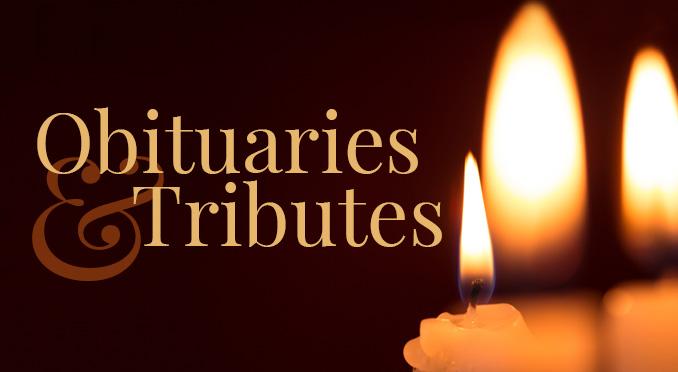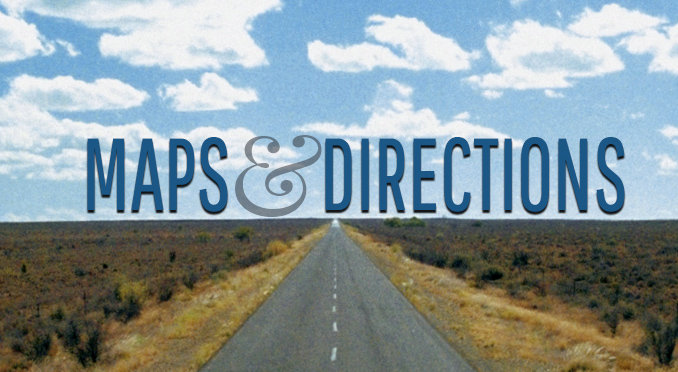Jewish Funeral Traditions & Customs
The Jewish tradition is rich in wisdom. At Brighton Memorial Chapel, we try to guide and gently assist the families we serve through the process necessary for funeral and burial. With this in mind, we wish to explain some of the customs, ceremonies and practical realities of dealing with death and mourning. We believe that a family that is informed and prepared can best handle their grief and loss. This outline is not intended to be all inclusive, but should instead create an open family dialogue that would encourage thoughtful advanced planning.
These separate pages contain information and definitions of common Jewish traditions and terms. Some of the traditions listed may fall under the Orthodox or traditional heading. Over time, the Conservative and Reform movements have modified some of these traditions. At Brighton Memorial Chapel, we are able to cater to your family’s needs. In certain instances, the rabbi, venue of the service or burial plot a family chooses will determine certain traditions in which to follow. We would advise you to consult your rabbi for any questions as to what he or she deems permissible.
Please know that we at Brighton Memorial Chapel, as well as any clergy in town, are always available to help answer questions that arise. We hope you will find this list helpful and guide you in your own discussions and practices.
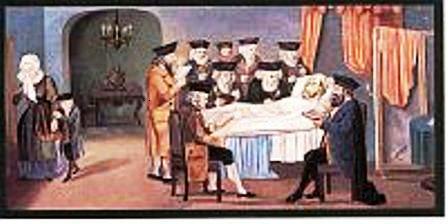 On the verge
On the verge
A goses is someone who is extremely close to death and is about to pass. Jewish law forbids anyone from doing anything to hasten a person’s death; at the same time it requires all actions possible to comfort the dying person. A goses should try to say the Vidui(confession) before he or she dies.
Vidui - Jewish Confession
When a person is on the verge of death, they are encouraged to say Vidui and confess their sins and make peace with God. Confession includes regretting all sins committed during their lifetime, through speech, thought and deed. At the brink of death, a person recognizes that they are about to stand before God, The Creator and Judge. This confession does not require a rabbi. The Vidui prayer can be found in any Siddur (daily prayer book). If a dying person is unable to speak the words, someone else may do so on his or her behalf. The Vidui Hebrew prayer is based on Proverbs 28:13.
יג מְכַסֶּה פְשָׁעָיו, לֹא יַצְלִיחַ; וּמוֹדֶה וְעֹזֵב יְרֻחָם.
13 He that covereth his transgressions shall not prosper; but whoso confesseth and forsaketh them shall obtain mercy.
Burial Of Limbs
Traditionally, limbs should be buried. If a person has a limb amputated, the limb should be buried in the spot where the person will eventually be buried. The family should make sure that the amputated limb is not discarded by hospital authorities. Brighton Memorial Chapel can assist in the burial of a limb, if the need arises.
Time between Death and Burial
Who is a mourner?
Mourners are those who are immediately related to the deceased. There are seven mourners in Judaism – husband, wife, mother, father, son, daughter, brother, sister. From the moment of death until burial takes place, these seven people are considered anonen (bereaved person), and have no religious obligations except for arranging the funeral. Once burial takes place, these seven onen officially become mourners.
Autopsies
While the soul or spirit leaves the body upon death, it is important to treat the body which once housed the soul or spirit with dignity and respect. Therefore an autopsy is contrary to Jewish law, since autopsies are viewed as a desecration of the body. In most cases when an autopsy is recommended, the family is able to refuse. There are some times when an autopsy may be required by law or is needed for other reasons. Consult your rabbi with any questions.
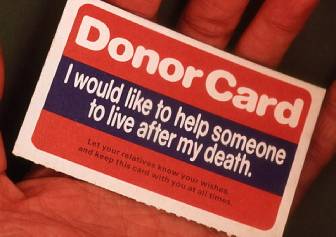 Organ Donation
Organ Donation
Is viewed as pikuach nefesh (the saving of a life.) It is a mitzvah (good deed) to bring matan chai'm (gift of life) or improve a life. If you wish to be an organ donor, please be sure to inform your family. Specific questions regarding organ donation should be directed to your rabbi. Click here to learn more information about organ donation in Monroe County:
Embalming
According to Jewish tradition, embalming (the unnatural preservation of the dead) and the use of cosmetics on the deceased are not permitted. Embalming is not required by civil law.
Viewing
Viewing is not traditionally a part of the Jewish custom. It is thought to be disrespectful because it creates an unequal relationship, because you are looking upon someone who cannot look back at you. However, there are some family members who may need to see their loved one to help face the reality of death. In some cases this is needed to help the grieving process, especially for relatives who have not seen their family member in a long time. It is best to remember a loved one when they were happy and well, and not be left with the lasting image of them lying in a casket. Upon request, Brighton Memorial Chapel can arrange for a family to have some private time prior to the funeral service.
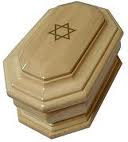 Cremation
Cremation
Cremation is not traditionally accepted in Judaism. The Jewish tradition is to be buried in the ground. Halakha(Jewish law) forbids cremation because it believes the soul will remain restless and wander for eternity. Another common belief is that Jews were burned to death over the centuries - during the Inquisition, in the wooden synagogues and ghettos of Europe, and in Nazi concentration camps during the Holocaust. Some believe it is inappropriate for us to willingly add to the cremation of our people and is often viewed as blasphemy. Some Jewish families that are reform or not very religious choose cremation. People chose cremation because it is less expensive or because it is more ecologically friendly. Brighton Memorial Chapel offers cremation for families that request it. There are many options once the cremation takes place. Ashes can be buried (depending if there are any religious requirements within the cemetery section), scattered at sea or to the “four winds”, or given back to the family, just to name a few. A service is often held before a burial, but many people are unaware that the same opportunities are also available before or after the cremation process. We will help design a final tribute that is unique and personalized for your family and friends. The service can be small or large, private or public, and with any type of officiate whether it be a rabbi or someone chosen by the family. The same prayers are said at a memorial service as would be said at a traditional service. Your rabbi should be contacted for guidance.
Shmira - Sitting with the deceased
Tradition encourages, as an act of great respect that the body not be left alone from the time of death until burial. The shomer (watcher) who p ["Watcher" - Germany 1754] erforms the Shmira can be a family member, friend, or member of the community. Brighton Memorial Chapel can arrange for a student from the Talmudic Institute of Rochester to act as a shomer, if requested.
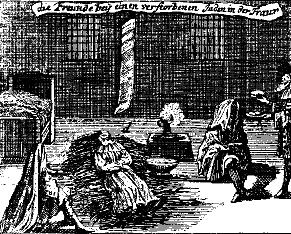 Shomer - Guard or Watcher
Shomer - Guard or Watcher
Who is a religious Jew, who recites psalms near the deceased. Traditionally, the deceased is not to be left alone before burial. In the absence of a family member or friend familiar with the prevailing customs, a shomer can be arranged by the funeral home. Traditionally, Psalms (T’hillim) are recited at the time of death.
Neshama - The God given soul.
In Judaism, it is believed when a person dies, the soul or neshama, hovers around the body. This neshama is the essence of the person, the consciousness and totality. This includes the thoughts, deeds, experiences and relations of the deceased. The body was its container. Once a person is buried, the neshama is allowed to make its way to the Eternal World.
Chevra Kadisha - חֶבְרָא קַדִישָׁא
The Chevra Kadisha or “Holy Society” are members of the community who prepare the body for burial. They are a specially trained group of people who perform the mitzvah(Good Deed) of a taharah (Purification). These volunteers ensure that appropriate practices are followed.
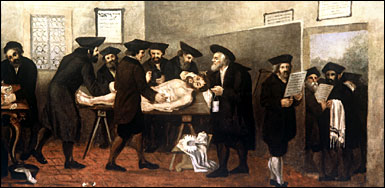 Taharah – טַהֲרָה
Taharah – טַהֲרָה
Ritual Washing - As newborns are washed and dressed as they enter the world, so are the dead as they leave this world. The traditional washing and dressing of the deceased is done with the utmost dignity and respect. Thetaharah is performed by trained members of the Chevra Kadisha(Sacred Society). In accordance with Jewish traditional law, men prepare men, while women prepare women. The Chevra Kadisha dresses the deceased in a simple white burial garment, called tachrichim. Men are also buried with their tallit (prayer shawl), which has been altered by removing one of the fringes. Dirt from Israel is symbolically placed under the head and on the deceased person, and pottery shards are placed over the eyes. Prayers asking for the forgiveness of the deceased and the soul’s eternal peace are offered. The Chevra Kadisha follows all laws that are in accordance with k’vod hamet(respect for the dead).
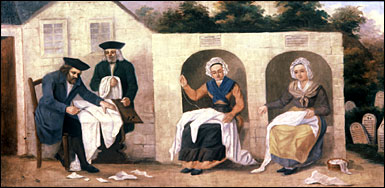 Tachrichim - תַּכְרִיכִים
Tachrichim - תַּכְרִיכִים
Burial Shroud - Traditional white clothing, preferably made of linen, includes: hat, shirt, pants, jacket, belt and wrapping sheet, and for a man, a tallis (prayer shawl), preferably his own, is also worn. The tachrichim is reminiscent of the garments the Kohanim (High Priest) wore when they entered the Great Temple on Yom Kippur (Day of Atonement). Some people are buried in the kittel, a simple linen robe; they may have worn at their wedding, during seders on Passover and during Yom Kippur. The shroud has no pockets, which symbolizes our inability to take along any material possessions on this journey. Rabbi Gamliel introduced this custom about fifty years after the destruction of the Second Temple. Before that, Jews were buried in the garments they wore during life. As time went on, the attire of the dead became more elaborate and extravagant. It became difficult for the poor Jews to show the highest respect for their dead while avoiding the great expense attached to clothing. The tradition of a simple shroud was adapted for the rich and poor, showing that all men are equal before God.
 Aron – The burial casket
Aron – The burial casket
In Judaism, the casket must be made completely of wood, with holes at the bottom. Like the tachrichim(burial shroud), the aron should be simple and unadorned. Our prophets tell us “From earth you have come, and to earth you shall return.” (Genesis 3:19). Wooden caskets help with this process in their organic nature, and disintegrate over time. Metal caskets are not permitted by Jewish law because metal is a sign of war. Brighton Memorial Chapel has a large selection of kosher caskets in all price levels, from a traditional pine box to solid mahogany. This is a decision a family will decide on privately, and whatever casket is selected will be appropriate.
Scheduling a Funeral
How soon after death should the funeral be held? – Jewish tradition mandates burial as soon as possible. Long ago, when families lived close together in small communities, burial was usuallcompleted by sundown on the day of the death (the Jewish day begins at sundown and ends the following sundown; hence burial was completed in the day of death). With families spread all over the country and world, funerals can be delayed for travel. A funeral can be held within a few days of death. Arrangements should be made soon after learning of a death. The closest relatives and the rabbi should be called to insure that the funeral is held at the earliest possible time. In this way, respect for the deceased is maintained. Funerals should be scheduled to be compatible with the family, clergy, funeral home and cemetery’s availability. The following are days on which a Jewish funeral would not take place.
- Shabbat (Sabbath) starts at sunset on Friday night and ends an hour after sundown on Saturday night.
- Rosh Hashanah
- Yom Kippur
- Sukkot - (First two and last two days of the holiday)
- Shemini Atzeret
- Pesach (Passover) – (First two and last two days of the holiday)
- Shavuot
When a death occurs, the staff at Brighton Memorial Chapel will sit down with a family and help coordinate and schedule all aspects of the funeral.
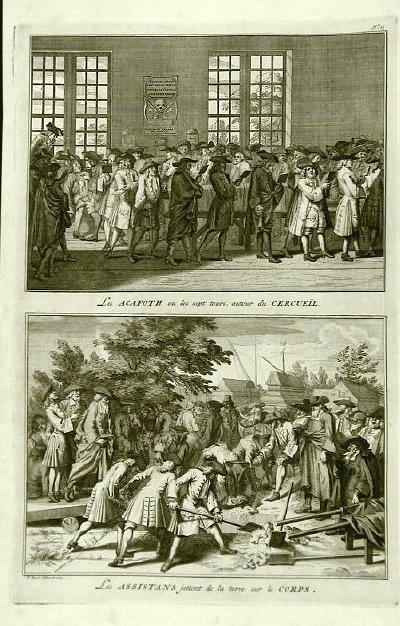 The Funeral Service
The Funeral Service
Depending on a congregation’s policy, a service may be held in the synagogue. Families that are not affiliated with a synagogue may choose to have a service in the chapel of the funeral home or a graveside service right at the cemetery. Often, it is ["Jewish Funeral" From Kirchliche Verfassung der heutigen Juden by Johann Christoph and George Bodenschatz, Frankfurt, 1756.] hard to predict how many people will be in attendance for the funeral. If the deceased is young or leaves a large family, or is active in the business or social activates of the community, it is likely that a large number of people will want the opportunity to pay their respects, by either being present at the funeral service or coming to the house of mourning afterward. With the idea that we are all equal, the services in these three locations all follow the same structure, and include the same prayers.
K’reah - קְרִיעָה
Rendering the Garment - This rite consists of tearing a visible portion of the mourner’s clothing, usually a shirt pocket, or blouse. Today, many families prefer to wear a black ribbon. This rite is performed by the rabbi with the family standing
together right before the funeral begins. The mourner’s say the words of Job, “The Lord has given and the lord has taken, blessed be the name of the Lord,” and recites a brakha (Blessing) which is a reaffirmation of faith and the value of life.
בָּרוּךְ דַיָּן הָאֱמֶת
“Barukh ata adonai eloheinu melekh ha-olam, dayan ha-emt” - Blessed is The Judge of Truth.”
 An initial cut is made and then the mourner takes the edge and gently tugs. The torn garment or ribbon is worn during shiva (period of mourning), except on the Sabbath. Children cutting k’reah for their parents, cut or wear the ribbon on the left side of their chest, over their heart. For all others, the k’reah is on the right side of the chest. It is customary to wear the torn garment or ribbon all seven days of shiva, except duringShabbat (Sabbath) and festival days. Some people wear it for the first 30 days of mourning (Shloshim). The idea of this tradition is that the rip in the fabric symbolizes the mourner’s heart. The garment can be sewed, but there will still be a mark that a tear was once there, just as a heart heals with time, but there will always be a scar for the loved one who is gone. This tradition dates back to biblical times. Jacob tore his garments when his sons showed him Joseph’s blood stained coat. King David also tore his clothes on hearing of the death of Saul and Jonathan. K’reah is only required for those who have lost a: Spouse, Father, Mother, Son, Daughter, Brother, Sister.
An initial cut is made and then the mourner takes the edge and gently tugs. The torn garment or ribbon is worn during shiva (period of mourning), except on the Sabbath. Children cutting k’reah for their parents, cut or wear the ribbon on the left side of their chest, over their heart. For all others, the k’reah is on the right side of the chest. It is customary to wear the torn garment or ribbon all seven days of shiva, except duringShabbat (Sabbath) and festival days. Some people wear it for the first 30 days of mourning (Shloshim). The idea of this tradition is that the rip in the fabric symbolizes the mourner’s heart. The garment can be sewed, but there will still be a mark that a tear was once there, just as a heart heals with time, but there will always be a scar for the loved one who is gone. This tradition dates back to biblical times. Jacob tore his garments when his sons showed him Joseph’s blood stained coat. King David also tore his clothes on hearing of the death of Saul and Jonathan. K’reah is only required for those who have lost a: Spouse, Father, Mother, Son, Daughter, Brother, Sister.
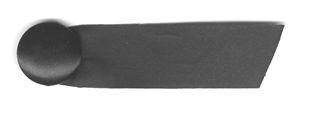
During the funeral service, the immediate family sits in the first row of the chapel or sanctuary. Traditionally, Jewish funeral services are brief and simple. The service usually includes the chanting of psalms and the El Moley Rachamim (the traditional memorial prayer for peace of the departed soul), and a hesped (eulogy) honoring the deceased. The casket remains in view during the service, sometimes covered with a black cloth called a pall. At the conclusion of the service, the casket is escorted by four to six pallbearers to the hearse. Except at an Orthodox service, both men and women may be pallbearers. Gentiles may serve in this capacity as well. Honorary pallbearers may also be invited to walk with the casket. This honor is given to people who are not required to lift the casket at any time. Of course, the staff of the funeral home is there to assist and direct. The pallbearers assist at both the funeral home or temple and then again at the cemetery.
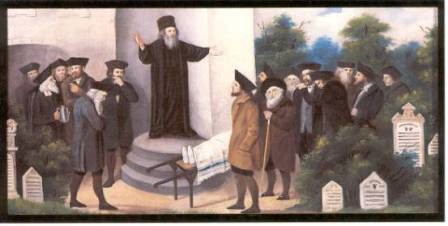 Eulogy - Hesped – הֶסְפּד
Eulogy - Hesped – הֶסְפּד
The rabbi, a family member or a friend can give the hesped (eulogy) alone or in combination. Eulogy means “a good word”. It is not an attempt to write an entire [Hesped - Eulogy] biography of the person, but to convey some of the personality and accomplishments of the deceased. The eulogizer also tries to express the sense of loss experienced by the survivors. Mourners are not required to give a eulogy, but may do so if they wish. The rabbi usually will meet with family prior to the service to learn more about the deceased to make the eulogy more personalized. This process is valuable not only for the writing of the eulogy but is also helpful for the mourners themselves. The sharing of memories may even begin the healing processes in some cases.
The Burial
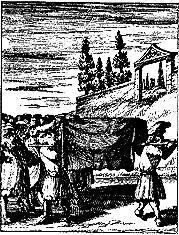 Pallbearers
Pallbearers
Selected by the mourners, four to six pallbearers are given the honor of moving the casket. As a sign of respect, the casket precedes the mourners. This custom dates back to biblical times when Jacob’s children carried him to his grave. Some rabbis have the pallbearers stop seven times while reciting the 91st Psalm. The stops represent the seven stages of life. Honorary pallbearers may also be designated. Traditionally, mourners do not act as pallbearers. If no pallbearers are available, staff from the funeral home can place the casket.
Cemetery Service
After the rabbi has finished with prayers, the casket is lowered into the ground. Family and friends may choose to fulfill the greatest mitzvah (good deed) of Chesed Shel Emet(a true act of loving kindness). This ultimate act of love and kindness is expressed to the deceased when mourner’s and friends participate in the actual burial. This can be achieved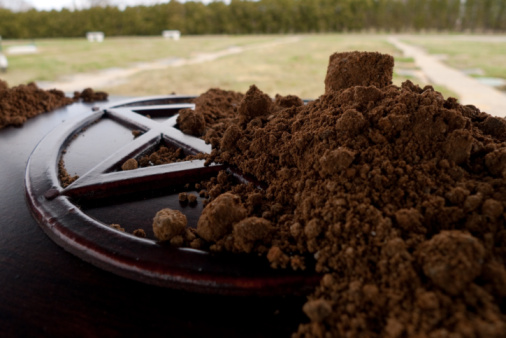 by placing a handful of earth on the casket or by using a shovel. Often, the first shovel of earth is done using the back part of the shovel. This is done to show that we are reluctant to say goodbye to our loved one. It also makes it more difficult to fill in the grave. This symbolizes that this particular act of using a shovel is different from any other occasion when it would be used, and that burying a loved one should be with reluctance and not be rushed.
by placing a handful of earth on the casket or by using a shovel. Often, the first shovel of earth is done using the back part of the shovel. This is done to show that we are reluctant to say goodbye to our loved one. It also makes it more difficult to fill in the grave. This symbolizes that this particular act of using a shovel is different from any other occasion when it would be used, and that burying a loved one should be with reluctance and not be rushed.
The Chesed Shel Emet חֶפֶד שֶׁל אֶמֶת
is the ultimate act of love and kindness, because the deceased can not ask the mourners to do it for them, nor are they able to repay the act or say thank you. Participating in thismitzvah (good deed), has been shown to have great psychological benefits for mourners, since it truly serves as an action of closure and finality, rather than leaving the casket above ground, with the mourners walking away. This helps minimize any illusion that the death might not have been real. Some people do not always feel comfortable witnesses this tradition. In this case, they may return to their cars as the casket is lowered. At an orthodox funeral, the Mourners Kaddish is not said until the grave is filled to the top and a mound is formed.
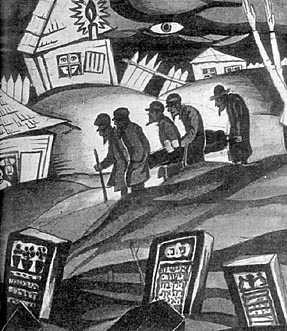 Graveside Service
Graveside Service
A funeral held exclusively at the cemetery includes the same elements as those at the funeral home or temple. A graveside service is shorter in length, because certain elements are repeated when the service is held in two locations. The same selections of Psalms and prayers are said, including the hesped (Eulogy). The El Moley Rachamim, which expresses our faith in the immortality of the soul, is recited, along with recitation of the Kaddish. At the conclusion of the burial service, those attending are asked to form two parallel lines to allow the mourners to pass through as they return to their cars.
Brighton Memorial Chapel and local law enforcement agencies would like to point out that criminals have been known to prey on grieving families while they are not home during a funeral service. We suggest that a friend be asked to watch the home while families are away.
Kaddish – קדיש
The traditional prayer in praise of God, said during every traditional prayer service. There are five variations of the Kaddish, with the best known being the Mourner’s Kaddish. This prayer never mentions death or dying, but instead proclaims the greatness of God. By saying the Kaddish, mourners are showing that even though their faith is being tested by their loss, they are still affirming’s God’s greatness. Some people believe the Kaddish is also said for the benefit of the soul of the deceased to help facilitate its journey. Traditionally, Kaddish is only said for immediate family, but you may say Kaddish for whomever you wish. Some people undertake the mitzvah (good deed) of saying Kaddishfor a person who left no family. The Kaddish is recited after burial, during the first year, at all three daily services and at the Yahrzeit. This prayer should be said by the mourners either in the home or at the synagogue, in the presence of a minyan (quorum of 10 Jews). This is done so that the mourners remain a part of the community, even if the natural instinct would be to withdraw. Synagogues can help arrange for a minyan if the family wishes to hold services at their home. Brighton Memorial Chapel can provide prayer books to be used as a courtesy. Children mourning a parent say Kaddish for 11 months. Traditionally, Kaddish is said for 30 days for a child, spouse, or sibling. Today, many people choose to say Kaddish for 11 months for any family member. Kaddish is also recited each year on the anniversary of the death (Yahrzeit) and at Yizkor. It is believed that the Kaddish is one of the most important and meaningful acts that the family can do to insure that the departed soul is at peace.
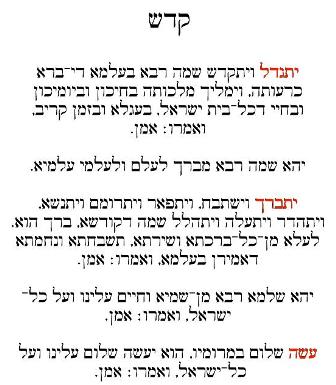
Form Two Parallel Lines
At the conclusion of the burial service, mourners leave the cemetery walking between aShura. A Shura is two parallel lines formed by family and friends in attendance that create a pathway. This is done as a show of support, and signifies that the shift from honoring the dead to consoling the bereaved. This is the first chance for people to express their condolences to the family, as now they are officially mourning. The standard words of comfort that are said as the mourners walk through the lines,
המקום ינחם אתכם בתוך שאר אבלי ציון וירושלים
“Ha-makom yinakhem et-khem betokh she-ar aveilei tziyon veyerushalayim,
May God comfort you among all the mourners of Zion and Jerusalem.”
Any kind words of sympathy may be expressed to the mourners from this point on. There is an expression in Hebrew that translates to “Words from the heart go directly to the heart” and any kind expression that is honest and meaningful is appropriate at this time.
Shiva means seven and is the period of mourning immediately following the burial. The day of burial counts as the first day of shiva, which continues for seven days. Although no public mourning is observed on the Sabbath, the Sabbath and holidays count in the seven days. Recently, the trend has been for families to “sit shiva” for only a few days. This is particular true of the reform and conservative movement. This is a personal decision that each family should discuss amongst themselves. Whatever decision a family makes, will be appropriate. This period of mourning is often observed at a family member or friends home. Other venues families have chosen include a private room at the Jewish Home of Rochester, Wolk Manor, the Summit at Brighton, a private room within our funeral home or even a restaurant for families that are reform.
How holidays and festivals affect Shiva
Many festivals affect the observance of shiva and your rabbi would be best qualified to explain how they affect a particular situation. For example, some festivals cancel the observance of shiva completely, and some festivals postpone the beginning of Shiva. Under special circumstances, the observance of shiva is for fewer than the traditional seven days. Shabbat (The Sabbath) is included in counting the seven days, though onShabbat no outward signs of mourning apply, such as the black k’reah ribbon.
On Friday (unless it is the seventh day of Shiva) or on the day before a festival, Shiva is observed until two and half hours before sunset. On Pesach (Passover) eve, it ends at noon. Pesach, Shavuot, Sukkot, Rosh Hashanah, and Yom Kippur, cancels the remainder of Shiva, provided that the mourner has first observed at least one hour ofShiva before the holiday began. If burial takes place on the intermediate days (Chol Hamoed) of the holiday of Pesach or Sukkot, then Shiva is not observed until after the end of the holiday. Again, we suggest you consult your rabbi as to a particular situation.
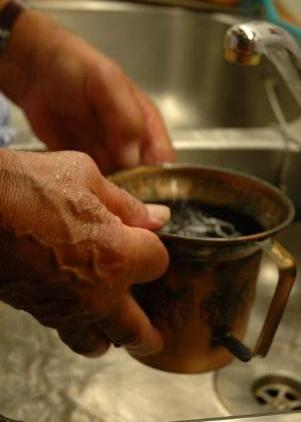 Washing of Hands
Washing of Hands
This is done after the funeral, after any visit to the cemetery, or after being in close proximity to a deceased we wash our hands. A container of water should be prepared for this purpose outside the entrance of the residence which one is about to enter forshiva. We wash our full hand from the wrist to the finger tips, three times alternately, first the right hand, then the left alternating, right, then left. The hands should be left to air dry, not towel dried. This tradition is from the early post-Talmudic period. It is done to dispel the spirits of uncleanness, which might cling to one’s person, these being the demons that follow people home. The tradition today is looked at as metaphorically cleansing from a place of death to a place of life. When washing your hands before entering a house of mourning, you are not supposed to pass the cup of water to the next person. The suggested reason for this custom is based in superstition. Just like the shovel used for burial, the vessel used for pouring water is not passed on as one might be passing death or the contamination of death to someone else.
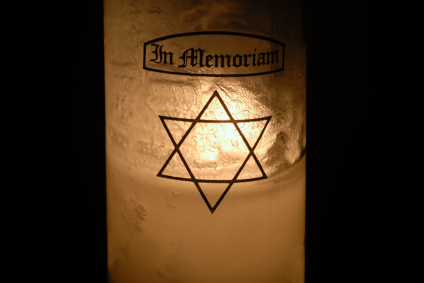 Lighting a Candle
Lighting a Candle
Traditionally, when mourners return to the house after the funeral, they light a candle that burns for the entire seven days. This candle is placed in a prominent spot in the room where people will be sitting the most. There is no blessing that is said when lighting this candle. This candle or plug in lamp should burn for the time the family is sitting shiva. Brighton Memorial Chapel provides a seven day candle or plug in lamp to families that request them. The light is symbolic of the soul of the departed. We use a light to remember someone who has brightened our lives. We also use a light to symbolizes God’s presence with Ner Tamid (the perpetual light) before the Ark in the synagogue. Amid the sadness and gloom of mourning, light is a symbol of hope and comfort. Candles are symbolic of the soul. A material physical candle burns with a lovely peaceful glow, turning itself into energy, and then the physical candle disappears into the air. So too, does the soul pass away from this world, no longer needing its physical body. The Bible teaches us that “the light of God is the soul of humankind.” (Proverbs 20:27). Theshiva candle is therefore symbolic of the soul of the deceased.
 Meal of Consolation - se’udat havra’ah - סעודת הבראה
Meal of Consolation - se’udat havra’ah - סעודת הבראה
One of the oldest, most important and meaningful traditions the Jewish people have is, upon returning to the house of mourning following the burial, the community provides the first meal. It is customary for the meal to be dairy and would include round foods such as hard boiled eggs, lentils or bagels, which symbolize the cycle of life. This meal of condolence was started because if it was left to the mourner’s own will, they may not eat and would become ill. Today, the community provides the first set of meals, because the mourners should not feel as if they are “hosting” a party, or that they be concerned about taking care of anyone else’s needs. Rather, the community is there to take care of the mourners.
Condolence Calls - Nichum Avaylim
A tradition of shiva is for the mourners to sit lower than their visitors. The mourners are not meant to be uncomfortable, but simply lower than others. This is to remind the mourners that the house of mourning is not to have a party like atmosphere. Doors are left unlocked so that visitors can enter the house without ringing the doorbell or knocking, as this distracts the mourners from their grief. Traditionally, mourners do not stand to greet visitors. The atmosphere in the house of mourning should be one of dignity, and one should avoid creating a party like atmosphere. Talk should be centered on the deceased. Shiva should be a time to remember with fondness many of the events of which the decease was a part. Mourners find comfort in hearing stories of their loved one. Although they may seem overwhelmed and upset, they would prefer people talk about their loved one rather than think that people have forgotten the person.
Many families do not observe shiva for a full week, or observe it to varying degrees. TheKaddish is said daily in the home or synagogue in the presence of a minyan (ten or more men. The reform movement includes women in a minyan). Some temples can arrange for a minyan to come to the house of mourning for services.
People visiting a house of mourning should not expect to be served or even offered food by any of the mourners, who thus would be acting in the inappropriate role of hosts at a social gathering. It is proper for relatives and friends to attend to the needs of the mourner and the household. Usually, gifts or flowers are not brought to a house of mourning, but food is often welcome. We would caution that many people keep kosher, and adhere to strict dietary rules. Click here for a link to a list of kosher vendors that could have food delivered to a house of mourning.
 Covering mirrors
Covering mirrors
The practice of covering the mirrors in the house was based on the belief that the spirit was attracted to the mirrors. Some people thought the soul could even be trapped in the reflection. Rabbis reinterpret this custom that vanity should be discouraged, and that one should concentrate on their inner reflection. This is the same reason orthodox men do not shave during shiva.
Pouring water out
There is an old custom of pouring water out of any bowls after a death of a loved one. The suggested reasons for this superstition were that the angel of death may have washed his sword in the water, and it may be harmful. Another thought is that water is reflective like a mirror, so one would pour the water out as not to see their reflection for the same reason we cover mirrors.
At the conclusion of shiva
To mark the end of shiva, it is customary for the mourners to take a short walk around the neighborhood, as a way of taking a first step back into the world. It is thought that the deceased abides with the mourners. The soul is there to comfort the family. This first walk is for the mourners to escort the soul out of the house, indicating that they are going to be alright.
The thirty days following burial, with the day of burial counting as the first day. Shiva(seven) is the first seven days of shloshim. Shloshim (thirty) ends on the morning of the thirtieth day after the funeral. The period from the end of shiva to the end of shloshim is one of transition from deep bereavement to resuming life's normal routine. This is the time when mourners return to work or school and begins living life without their loved one. Traditionally, during shloshim, a mourner avoids music and forms of celebration. As with shiva, some festivals affect the shloshim period. Your rabbi will advise you how a festival or life cycle event such as a previously scheduled wedding or Bar/Bat Mitzvah impacts this mourning period. When mourning a parent's death, restrictions continue for eleven months. This period is called Shneim asar chodesh שדוח רשע םינש. Children continue reciting the Kaddish during these additional months, whereas a mourner for all other relatives ends at shloshim.
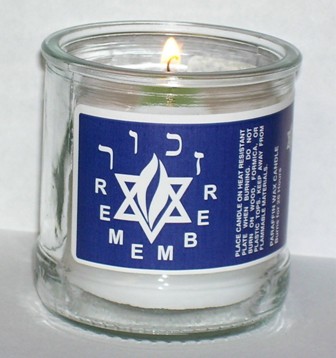 Yahrzeit - Anniversary of Death.
Yahrzeit - Anniversary of Death.
The yahrzeit is the annual anniversary of the death of a person based on the Hebrew calendar. This day is observed as a solemn day of remembrance. Yahrzeit is a [Brighton Memorial Chapel provides at no charge Yahrzeit candles to remember a loved one. Stop into the funeral home for a complimentary candle.] Yiddishword meaning “a year’s time.” The day is observed by lighting a memorial candle or light the evening before the day of theyahrzeit. This candle or light should burn for twenty-four hours. Often, people attend synagogue or a place where there is a minyan (10 Jewish men) on theyahrzeit day to say Kaddish for their loved one. If your temple notifies you of a family member’s yahrzeit, they will often read your loved one’s name on theShabbat (Sabbath) service before the actual yahrzeit date. Families often attend this service for that reason. It is also common for a family member to have an Aliyah, or to “go up” to the bima (the platform where the Torah is read) in honor of their deceased loved one. Lighting one candle for all relatives who have passed away is sufficient. Electric plug-in lights are a suitable replacement for people who do not feel comfortable with an open flame.
Yizkor –זכורי Memorial Prayers
On the major Jewish holidays (Yom Kippur, Shemini Atzeret, the last day of Passover and Shavuot) there is a memorial service called Yizkor. In Hebrew, Yizkor means “May God Remember.” Traditionally, a yahrzeit light is lit at sunset the night before each of these holidays, to remember a loved one.
Originally, in the 12th century, the Yizkor service was said only on Yom Kippur to remember and honor those who were killed in the progroms and the crusades. Over the years, Yizkor became a service to remember our own loved ones as well as the Jewish martyrs. About 400 years ago the Yizkor service was added to the liturgy of Passover(Yizkor is observed on the last day of Passover), Shemini Atzeret (8th day of Sukkot) and the second day of Shavuot. The Mourner’s Kaddish is part of the Yizkor service.
People who have lost a parent, spouse, child or sibling usually stay for the Yizkor service. In some congregations, those who have not lost anyone for whom to say Yizkor, often leave the sanctuary. In other congregations, everyone stays for the Yizkor service. Sometimes, additional prayers are said for Jewish martyrs and victims of the Holocaust.
In the Yizkor service we remember those who have died, but the word “Yizkor” is actually a request that we make of God to remember the deceased. Remembrance, then, is something that we do in partnership with God.
Monuments - מצבה
It is customary to place a monument (matzeivah), on a grave, dedicating it in a brief ceremony, known as unveiling, which usually takes place within a year after the death. However, it may take place at any time after the thirty-day period.
There are a variety of practices concerning inscriptions, though the tendency emphasizes simplicity. The English name of the deceased, and often their Hebrew name, dates of birth and death, and certain Hebrew letters are generally included. These letters are the initials of the words in the phrase tehei nishmato/nishmatah tzereurah bitzror ha-yahim.(Tuf, nun, tzadi, bet, hay) ת׳ נ׳ צ ׳ב׳ ה ׳ , which means, "May his/her soul be bound up in the eternal bond of life." Another Hebrew text often included is the abbreviation Pe Nun, for “Here is buried.” Which reads,פ ׳ נ ׳. While the formal unveiling of a monument is of significance to the family and friends, Jewish tradition has not emphasized it as a basic ceremony. Care should be taken to avoid the extremes of either another funeral or a festive reunion, at the cemetery or at home. Often, a Rabbi or Cantor conducts a brief service at the gravesite. Families can offer their own service and recite appropriate prayers and psalms. These prayers are available under the Prayers & Meditationpage on our website or through your synagogue’s office. Respect paid to the memory of the dead is not confined to the site where the earthly remains are interred. But as the grave does symbolize a memorial for the dead, it is an appropriate place for family and friends to gather in respect. The formal unveiling itself is a symbol, signifying that we open our hearts to the memory of the dead, to the meaning of their lives, to their influence upon us, and to appropriate ways of perpetuating their devotion. In older cemeteries, the Sephardim(Jews of Spanish decent) usually have horizontal stones, so that nobody is higher than anyone else in death.
 Unveiling
Unveiling
A monument is erected at the grave any time after shloshim (30 days). The unveiling ceremony usually occurs around the time of the first yahrzeit. Before the ceremony, the headstone is covered with a white sheet. Either a rabbi or the family can recite psalms and say a few word s about the deceased. Included are the reading of a few psalms the chanting of El Molya Rachamim, and at the end of the ceremony the covering is removed and the Kaddish is recited. This service is typically short, and is usually attended by invitation only. It is not a requirement in Judaism, but has become a tradition in the United States.
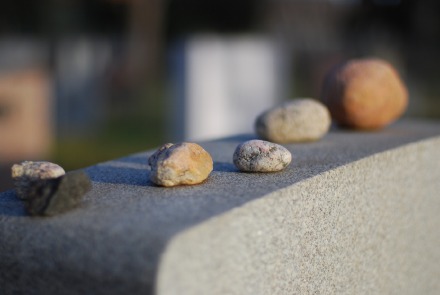 Why do people place small stones on the monuments?
Why do people place small stones on the monuments?
The origin of this goes back to Biblical times, when graves were often marked with a pile of stones. After some time, the elements made the stones disperse, and it was necessary for the piles to be built up again. Nowadays, we mark stones with a permanent marble or granite monument. By placing a pebble on the grave, the visitor is helping preserve the memory of the deceased. Just as the stone lasts forever, so too does the soul live forever. Another thought is that by placing pebbles on the grave, it shows that respects are still being paid, and that the deceased is still loved and remembered.
For common Jewish symbols on monuments and monument pricing click here.
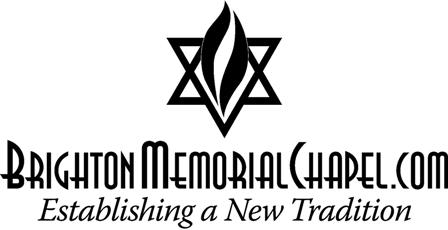 Why is the flame a symbol of Jewish death?
Why is the flame a symbol of Jewish death?
In Judaism, candles are the universal symbol for the divine spark that inhabits the body. The Bible states,כז נֵר יְהוָה, נִשְׁמַת אָדָם חֹפֵשׂ, כָּל-חַדְרֵי-בָטֶן “The sprit of the human is the lamp of the Eternal” (Proverbs 20:27). This is why, Brighton Memorial Chapel, and many other Jewish funeral homes have a flame associated with their logo
 Why do some people throw grass over shoulder?
Why do some people throw grass over shoulder?
There is a custom of plucking grass from the cemetery. The Chief Rabbi of Safed, Moshe ben Yosef Trani, (1500- 1580) stated that we pluck the grass after the burial as a reminder of the resurrection. The idea stems from Psalm in the passage from theShulchan Aruch (72:18): “They shall spring up as the grass of the field.”
Can there be a fraternal ceremony at a Jewish funeral?
Locally, many Jewish men are members of either the Knights of Pythias, Odd Fellows or a Masonic Lodge. Usually, fraternal services are not done at a Jewish funeral, but it would depend on the venue of the service and the rabbi officiating.

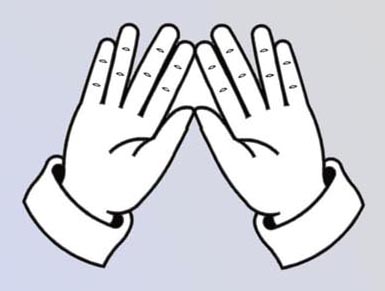 What are the rules for Kohanim?
What are the rules for Kohanim?
The Torah lays down special rules for the descendants of Aaron who conducted the sacrifices in the Tabernacle and later in the Temple. Members of this family were known as Kohanim (the plural of Kohen) which means priest. The Torah states that a Kohenshould not make himself unfit for priestly duty by coming into the presence of a dead body except for close relatives. Despite the fact that they are no longer called upon to offer sacrifices, Kohanim are still not permitted to be under the same roof as a corpse, unless it is for one of the seven close relatives within Judaism. Nor should he come within six feet of a grave. It is also a common practice to bury Kohanim by the side of paths so that relatives can visit without being regarded as defiled. In order to avoid breaking these laws, Brighton Memorial Chapel is able to provide a Kohanim room, with a separate roof line for mourners to participate, with our state of the art audio and video system.
Seven is a common theme in Judaism. What are some examples?
The number seven appears prominently in Judaism. Below are just a few examples:
- Shabbat (Sabbath) is on the 7th Day of the week.
- On Sukkot we shake 7 species - 1 Lulav, 1 Esrog, 2 willows, and 3 myrtles.
- There are 7 holidays in the Jewish year: Rosh Hashana, Yom Kippur, Sukkot, Chanukah, Purim, Passover, and Shavuot.
- At every Jewish wedding, 7 blessings are recited (Sheva Brachot).
- Each Shabbat, 7 people are called to the Torah reading (Aliyot).
- Traditionally, the bride circles the groom 7 times under the chuppah (wedding canopy).
- We wind the tefillin straps around the arm 7 times.
- God Created 7 levels of heaven. (Hence the expression, "I'm in 7th heaven!")
- On Shabbat and holidays, we recite 7 blessings in the silent Amidah.
- We dance 7 circles (hakafot) on the holiday of Simchat Torah.
- We conclude our Yom Kippur prayers by proclaiming 7 times, "The Lord is God!"
- We recite 7 blessings every day before and after the "Shema" (3 in the morning and 4 at night).
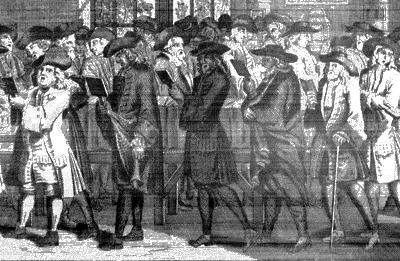 The number seven is prominent in funeral customs as well.
The number seven is prominent in funeral customs as well.
Shiva, referring to the seven day mourning period, is based on the Hebrew word for seven. The Jewish custom of mourning is based on the verse in Genesis 50:10, where Joseph mourns his father Jacob for a week.
At an orthodox service, the pallbearers stop seven times while carrying the casket to the grave, while Psalm 91 is recited. The stops represent the seven stages of life.
The Sephardic (Jews of Spanish decent) have the custom of placing the casket on the ground and walking around it seven times before it is placed at the grave.
Should Children Attend the Funeral?
This is a decision for the family to make. There is no set rule. If a child is old enough to understand the purpose of the funeral, and to know that people are upset, then generally that child should come to the funeral. Their prese [For a copies of these pamphlets, stop by the funeral home] nce aids in understanding the finality of death. Some children may be more frightened by what they imagine, then by what actually happens. A child ages 8 to10 on should be permitted to attend, but a child should never be forced. Allow a child to make their own decision after explaining to them what they will encounter. By witnesses the burial, a child may get the realistic answers to the questions “Where is my loved one now?” Children deserve the right to say goodbye and express their love to someone significant in their lives. It is important that an adult take time to explain what has happened, to listen to the child’s feelings and to dispel any mistaken conclusions that might have drawn. A rabbi is often willing to talk with a child before the service as well as share available resources. If a child chooses not to attend, perhaps writing a note to a loved one can serve as a goodbye. These notes may be placed in the casket, unless a taharah (ritual washing) is requested. Brighton Memorial Chapel has pamphlets regarding children and death. “Talking With Young Children About Death, A Message from Fred Rogers (of Mister Roger’s Neighborhood) and How to Explain Death to Children by Rabbi Earl A. Grollman, D.D. are available, at no charge.
Naming a Child
It is traditional to name a child after a deceased relative in order to perpetuate the memory and to express hope that the positive qualities of the deceased find expression in the child’s life. The Sephardic (Jews of Spanish decent) practice is to name a child after a living relative.
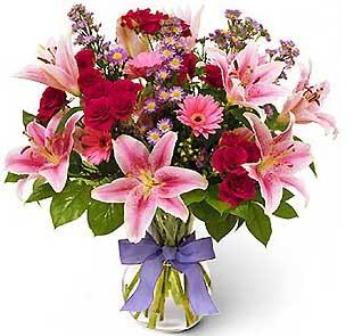 Why Flowers are not part of the Jewish Funeral
Why Flowers are not part of the Jewish Funeral
Flowers are not a part of the Jewish burial customs, and are strongly discouraged because in a few days time they will wither, providing a painful symbol of the family's loss. Instead, people are encouraged to give tzedakah (charity). Tzedakah is a traditional way to give a meaningful and enduring tribute in memory of a person. Making a contribution in memory of the deceased to a temple, school, organization, hospital or any other charity, especially one in which the deceased had an interest in, is a sign of respect, and helps in keeping that person's memory alive. Donations are requested in one's memory, often in lieu of flowers, with the hope that a donation to a charity will go much further, and benefit more people, then the few days flowers would be enjoyed. Click here for more info.
Why is Kaddish recited for only 11 months, when the mourning period is 12 months?
According to Jewish tradition, the soul must spend some time purifying itself before it can enter the world to come. The maximum time required for purification is 12 months, for the most evil person. To recite Kaddish for 12 months would imply that one’s parent was the type of person who needed 12 months of purification. To avoid this implication, the Sages decreed that a child should recite Kaddish for only eleven months.
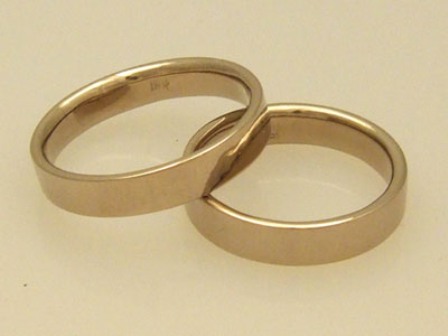 Funerals for intermarried couples
Funerals for intermarried couples
According to the National Jewish Population Survey 2000-01, 47% of marriages involving Jews in the United States between 1996 and 2001 were intermarriages with non-Jewish partners. Rates of intermarriage have increas ed in other countries as well. Because Brighton Memorial Chapel is a strictly Jewish funeral home, we would only handle the funeral arrangements for the Jewish spouse. Because we share space with Miller Funeral Homes, an all faith funeral home, we are in a unique position to help intermarried families. The sharing of the two funeral homes allows us to give intermarried families some uniformity to funeral services. Families can use our chapel for both sets of services, choose similar merchandise and be pointed in the direction of burial plots where both husband and wife can be buried next to one and other.
When can you visit a grave?
Depending on whom you ask, mourners should not visit the cemetery for the first thirty days (shloshim). Others, say the mourners can visit the grave after the conclusion ofshiva. Many people visit the cemetery on the occasion of yahrzeit. Individuals can offer prayers and recite psalms in Hebrew or English. It is traditional that when you attend a burial, you do not visit anyone else’s grave. This is done out of respect to the person who is being buried. The exception to the rule is that if someone has traveled a great distance, or if another trip will cause undue hardship, then one is allowed to visit someone else’s grave. Jewish custom indicates that stones, picked up at the grave site, may be placed as a memorial sign on the monument. After the visit, one washes the hands as a symbol of purification.
Tattoos
While halakha (Jewish law) forbids tattoos, there is a common myth that Jews with tattoos are not permitted to be buried in Jewish cemeteries. This is not true, and a Jew with a tattoo would receive a normal funeral service. Survivors of the Holocaust were forced to have numbers tattooed onto their arm. This does not prevent them from a proper Jewish burial.
The Jewish Month of Adar
The yahrzeit of a person who died during the month of Adar in a regular year is observed in a leap year during Adar I. Similarly, there are other special cases involving the yahrzeit of a person who died on the thirtieth day of Marcheshvan, Kislev or First Adar, all of which are dates which do not occur every year. In all such circumstances, the rabbi should be consulted to determine the correct yahrzeit date.
Afterlife & Reincarnation
Judaism teaches that death is not the cessation of our existence. Rather, death is a transition from one state of being to another -moving from this world (Olam Ha’ze) to the world to come (Olam Ha’ba).
The Prophet Ezekiel spoke of resurrection during his exile in Babylon in 550 BCE. He wrote in Ezekiel 37:11-12
יא וַיֹּאמֶר, אֵלַי, בֶּן-אָדָם,
הָעֲצָמוֹת הָאֵלֶּה כָּל-בֵּית יִשְׂרָאֵל
הֵמָּה; הִנֵּה אֹמְרִים, יָבְשׁוּ
עַצְמוֹתֵינוּ וְאָבְדָה תִקְוָתֵנוּ
נִגְזַרְנוּ לָנוּ.
יב לָכֵן הִנָּבֵא וְאָמַרְתָּ אֲלֵיהֶם,
כֹּה-אָמַר אֲדֹנָי יְהוִה, הִנֵּה אֲנִי
פֹתֵחַ אֶת-קִבְרוֹתֵיכֶם וְהַעֲלֵיתִי
אֶתְכֶם מִקִּבְרוֹתֵיכֶם, עַמִּי;
וְהֵבֵאתִי אֶתְכֶם, אֶל-אַדְמַת
יִשְׂרָאֵל.
11 Then He said unto me: 'Son of man, these bones are the whole house of Israel; behold, they say: Our bones are dried up, and our hope is lost; we are clean cut off.
12 Therefore prophesy, and say unto them: Thus saith the Lord GOD: Behold, I will open your graves, and cause you to come up out of your graves, O My people; and I will bring you into the land of Israel.
Ezekiel’s famous vision of the “Valley of Dry Bones” may be interpreted metaphorically as the collective destiny of the Jewish people and not necessarily indicative of a post death fate. However, as history has proven, the Jewish people have returned to the land of Israel after 2,000 years of wandering, and a symbolic resurrection occurred.
According to mainstream rabbis, a collective resurrection would occur at the “end of days,” ushering in the arrival of the Messiah, where a New World order would be established, and all bodies would arise; their souls restored to them. This notion of a physical resurrection has been a source of comfort and hope for many throughout history.
| Adar | The last month of the Jewish lunar year |
| Alav ha-sholom (masculine) Aleha ha-shalom (feminine) | “May peace be upon him/her" |
| Aliyah | Blessings recited by honoree on being called to the Torah |
| Aninut | Time period from death to burial |
| Aron | Casket carrying the physical remains of a Jew |
| Bima | Platform where the Torah is read at Temple |
| bikkur cholim | Visiting the sick |
| Brakha | Blessing |
| Chesed shel emet | Compassionate concern and kindness of the living for a deceased |
| El Malay Rachamim | Memorial prayer recited at funeral service, on visiting a gravesite, during Yizkor services |
| Gosses | someone who is extremely close to death and is about to pass |
| Hesped | Eulogy of tribute to a deceased |
| Chevra Kadisha | Holy society of men or women who wash and clothe a deceased in keeping with Jewish tradition |
| Halakha | Jewish Law |
| K’reah | Tear in a garment of a mourner |
| K’vod Ha-met | Respect for the deceased |
| K’vurah | Burial of the deceased |
| Kaddish | Aramaic language prayer in praise of God, recited by mourners |
| Kittle | Long white rob for the burial shroud |
| Kohen | One of three categories to designate a Jew based on birth lineage |
| Kohanim | High Priest |
| K’tonet | Shirt used in burial shroud |
| Levi | Category of Jew based on birth lineage |
| Matan chai'm | Gift of life |
| Matzeivah | Monument |
| Michnasayim | Pants used in burial shroud |
| Minhag | A Jewish custom, often becomes normative practice |
| Minyan | Quorum of ten Jews required for public prayer |
| Mishnah | Third century C.E. compilation of Jewish law |
| Mitznephet | Head Covering for the burial shroud |
| Mitzvah | Divine (or rabbinic) commandment incumbent to be fulfilled by Jews- good deed |
| Ner Tamid | Perpetual light |
| Neshama | God given soul |
| Nichum Avaylim | Comforting the mourners after burial and for the seven days of shiva |
| Olam Ha’ze | This world |
| Olam Ha’ba | The world to come |
| Onen | Those individuals who have suffered a loss—after the death until the burial |
| Pesach (Passover) | Eight day holiday, Feast of Freedom |
| Pikuach nefesh | The saving of a life |
| Rosh Hashanah | Jewish New Year |
| Sephardic | Jew of Spanish decent |
| Se’udat havra’ah | Condolence meal served to mourners upon return from cemetery burial |
| Shura | two parallel lines formed by family and friends in attendance that create a pathway |
| Shemini Atzeret | Eighth day of assembly, immediately follows Sukkot, precedes Simhat Torah |
| Shabbat | Weekly day of rest, Saturday, in Jewish tradition |
| Shalom | Means peace, completeness; hello or goodbye |
| Shanna | Year. Applies to the eleven months of Kaddish |
| Shavuot | Two day holiday, seven weeks after Pesach, marks giving of Torah by God to Jewish people |
| Shiva | Seven day mourning period begins after burial |
| Shloshim | Thirty day continuing mourning period; twenty three days plus shiva |
| Shmirah | Attending to the deceased body, remaining at all times until burial |
| Shneim asar chodesh | Restrictions for eleven months, when mourning a parent's death |
| Shomer | The person who attends to the body, recites psalms to honor deceased |
| Siddur | Daily prayer book |
| Sovev | Sheet used in burial shroud |
| Sukkot | Jewish holiday literally "booths.” Known as Feast of Booths or Feast of Tabernacles |
| Tachrichim | Full burial shroud placed on deceased |
| Taharah | Ritual washing of deceased by Chevra Kadisha. T’hillim (Psalms) recited while attending to deceased |
| Tallis | Prayer shawl |
| T’hillim | Psalms |
| Torah | Represents the first five books of the Old Testament |
| Tzedakah | Act of righteousness, donation in memory of deceased to a worthy organization |
| Vidui | Jewish confession |
| Yahrzeit | Yiddish. Anniversary of the death |
| Yisrael | Category of Jew based on birth lineage |
| Yizkor | Remembrance. Memorial prayers recited at synagogue service on four Jewish holidays |
| Yom Kippur | Day of Atonement. Twenty five hour period of reflection, prayer, repentance; non-eating or drinking by Jewish community |
Please know that we at Brighton Memorial Chapel, as well as any clergy in town, are always available to help answer questions that arise. We hope you will use our website as a means of reference. If you would like any printed information, we have pamphlets available at the funeral home.
About Us
Opened as an alternative for our community, it is our mission to provide the Jewish population of Rochester with an affordable, modern and convenient choice at a time when the need is most important. We pledge to utilize our local ownership to offer a dignified array of services to Jewish families, and give back to the community we live in and serve.
Our Location
Brighton Memorial Chapel
3325 Winton Road South
Rochester, New York
14623
Phone: (585) 427-8520
Fax: (585) 424-6952
Email: brighton@brightonmc.com

